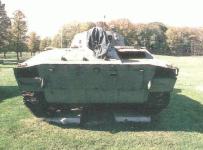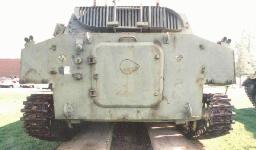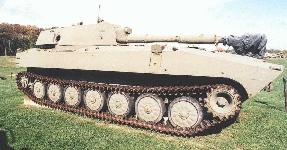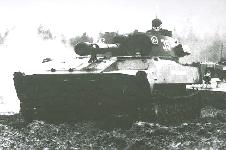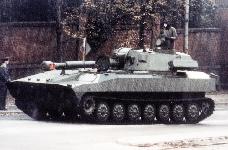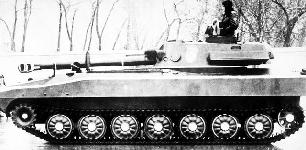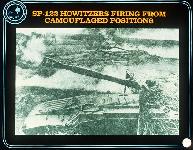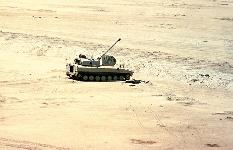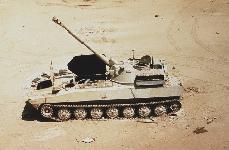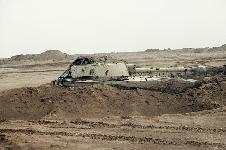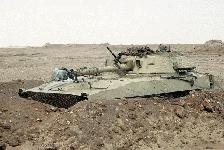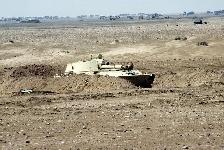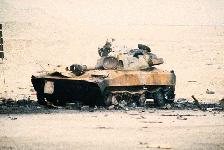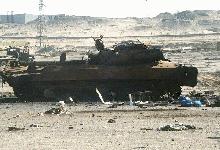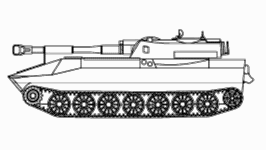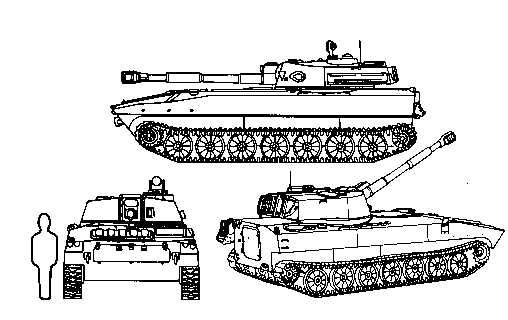
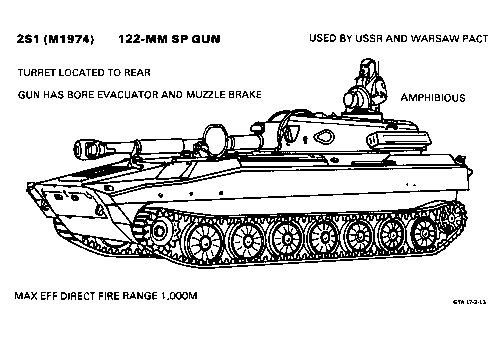




While the chassis of the 2S1 somewhat resembles that of the PT-76, it is essentially a new design, derived from the MT-LB chassis. The 2S1 has seven road wheels (versus six for either PT-76 or MT-LB) and no return rollers, with the drive sprocket at the front and the idler at the rear. As with the MT-LB, two different widths of track can be fitted, the wider tracks lowering the ground pressure and facilitating travel over soft terrain. The amphibious 2S1 is driven through the water by its tracks.
The boat-like hull contains the engine compartment at the right front and the driver's compartment at the left front, with the driver's hatch to the left of the gun tube. The fighting compartment in the rear of the hull is topped by a low-silhouette, rotating turret. Atop the all-welded turret are the commander's cupola (with single hatch cover) on the left and the loader's hatch on the right. The gunner, also located in the left side of the turret, has no hatch. The commander and driver have IR night sighting equipment, but there is no IR gunnery equipment. An interesting feature on the turret is the tear-drop shaped port cover on the left front near the gunner's position. The 2S1 has a direct fire sight besides its panoramic telescope. The vehicle is fitted with a collective NBC overpressure and filtration protective system.
The long 122-mm howitzer mounted on the rounded front of the turret is derived from the towed 122-mm howitzer D-30. The double-baffle muzzle brake is flush with the forward edge of the hull, and the bore evacuator is located midway along the tube.
The 2S1 can be quickly distinguished from the 152-mm self-propelled howitzer 2S3 by the smaller turret and less massive gun on the 2S1. The 2S1 also has a single unit shield for the recoil-recuperator mechanism above the tube, while the 2S3 has two separate cylinders above the tube. Also, the tube of the 2S1 does not extend beyond the front of the vehicle, while the 2S3 tube does.
CAPABILITIES:
The 2S1 is found in the howitzer battalion of BMP-equipped motorized rifle regiments and some tank regiments. Since it is tracked and amphibious, it has the cross-country capability necessary to keep pace with supported BMPs and tanks. It has a maximum range of 15,300 meters and is also used extensively in a direct fire role against armored vehicles or to breach minefields and other obstacles.
The vehicle has a relatively light weight of less than 1 6 metric tons, with a ground pressure of approximately 0.5 kg/cm2. This enables it to operate in swamps and deep snow and also contributes to its amphibious capability. It is propelled by track drive in water as well as on land. The light weight and low profile also make air-lifting easier. The tightly sealed hull with its filtration system enables the 2S1 to operate in irradiated or contaminated zones as well as under heavy dust conditions. The turret is mounted with a ball-bearing race and has an electric drive for rapid traverse, although precise aiming is performed with a manual drive. A ramming mechanism speeds up the loading process, and fired cases are ejected automatically.
LIMITATIONS:
Because of its light weight, the 2S1 offers only slight armor protection for its four-man crew.
REMARKS:
Since the 2S1 was seen in public for the first time in 1974, it also has been known under the provisional designation M1974. It also has been referred to as SP-74 and SAU-122. Although the 2S1 has been variously referred to as a gun, a gun-howitzer, or a howitzer, the Soviet press called it a howitzer. Its introduction coincided with the expansion of the Soviet motorized rifle regiment's artillery battery to a battalion and with the introduction of the ACRV M1974, which is associated with self-propelled artillery units. The self-propelled howitzer 2S1 provided the Soviet Army with highly mobile firepower that fit neatly into its doctrine of the offensive. It also was found in some non-Soviet Warsaw Pact armies.
Specifications | ||
| Alternative Designations | 122-mm 2S1 Gvozdika | |
| Date of Introduction | 1974 | |
| Proliferation | At least 12 countries | |
| Description | ||
| Crew | 4 (section of 6 with 2 in ammo carrier) | |
| Platform (chassis) | MT-LBu | |
| Combat Weight (mt) | 15.7 | |
| Chassis Length Overall (m) | 7.26 | |
| Height Overall (m) | 2.72 | |
| Width Overall (m) | 2.85 | |
| Automotive Performance | ||
| Engine Type | V-8, 300 hp, Diesel | |
| Cruising Range (km) | 500 km | |
| Speed (km/h) | ||
| Max Road | 60 | |
| Max Off-Road | 30 | |
| Cross-Country | INA | |
| Max Swim | 4.5 | |
| Fording Depths (m) | Amphibious | |
| Emplacement Time (min) | 2 | |
| Displacement Time (min) | 1 | |
| Radio | R-123M | |
| Protection | ||
| Armor, Turret (mm) | 20 | |
| Armor Turret Top (mm) | 10 | |
| Armor Hull (mm) | 15 | |
| Self-Entrenching Blade | No | |
| NBC Protection System | Yes | |
| Smoke Equipment | No | |
| ARMAMENT | ||
| Main Armament | ||
| Caliber, Type, Name | 122-mm, canon, 2A31 | |
| Barrel Length (cal) | 36 | |
| Rate of Fire (rpm) | ||
| Burst | 5 | |
| Normal | 4 | |
| Sustained | 1-2 | |
| Fire from Ground | INA | |
| Loader Type | Semi-automatic | |
| Breech Type | Horizontal sliding wedge | |
| Muzzle Brake Type | Double baffle | |
| Traverse | (�) | |
| Left | 360 | |
| Right | 360 | |
| Total | 360 | |
| Elevation (�) (-/+) | -3/+70� | |
| FIRE CONTROL | ||
| Indirect Fire | PG-2 Panoramic Telescope (PANTEL) | |
| Direct Fire | OP 5-37 | |
| Collimator | K-1 | |
| Gun Display Unit | None | |
| Fire Control Computer | None | |
| VARIANTS | None | |
| MAIN ARMAMENT AMMUNITION | ||
| Caliber, Type, Name | ||
| 122-mm Frag-HE, OF-81 | ||
| Indirect Fire Range (m) | ||
| Minimum Range | 1000 | |
| Maximum Range | 15,300 | |
| Complete Projectile Weight (kg) | 21.76 (OF-56) | |
| Muzzle Velocity | 680 m/s | |
| Fuze Type | RGM-2 PD | |
| 122-mm, HEAT-FS | ||
| Direct Fire Range (m) | ||
| Minimum Range | 0 | |
| Maximum Range | 1000 | |
| Armor Penetration (mm) | 460 (@ 0� obliquity any range) | |
| Complete Projectile Weight (kg) | 21.58 | |
| Muzzle Velocity | 740 m/s | |
| Fuze Type | GPV-2 PIBD | |
| 122-mm Frag-HE Rocket Assisted | ||
| Indirect Fire Range (m) | ||
| Minimum Range | INA | |
| Maximum Range | 21,900 | |
| Complete Projectile Weight (kg) | 21.76 (3OF-56) | |
| Muzzle Velocity | INA | |
| Fuze Type | PD | |
| Other Ammunition Types | Incendiary, Chemical, Flechette, Expendable Jammer, Semi-active laser-guided Kitolov-2M Frag-HE | |


